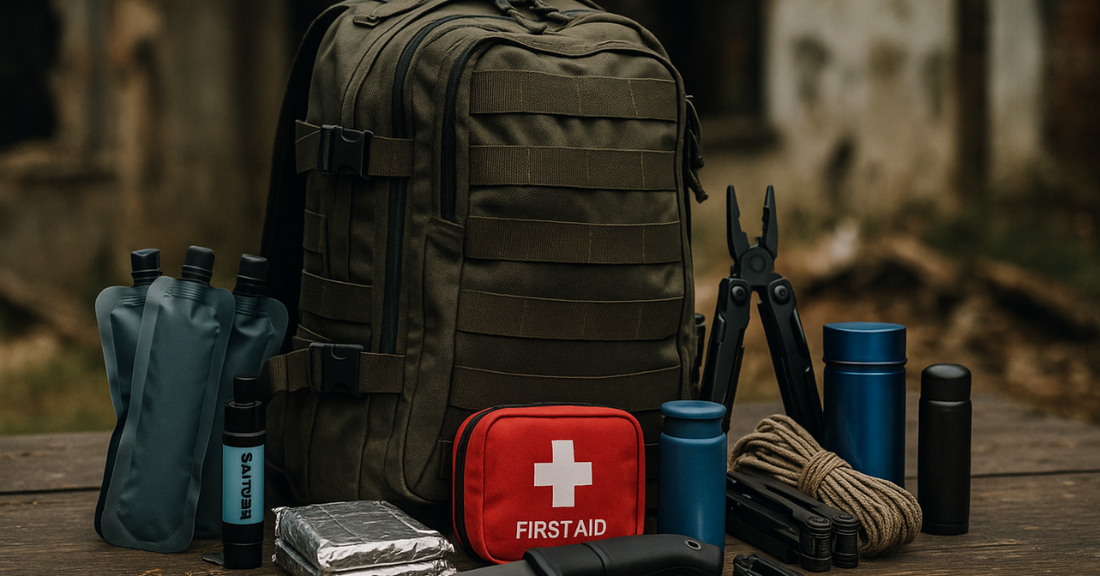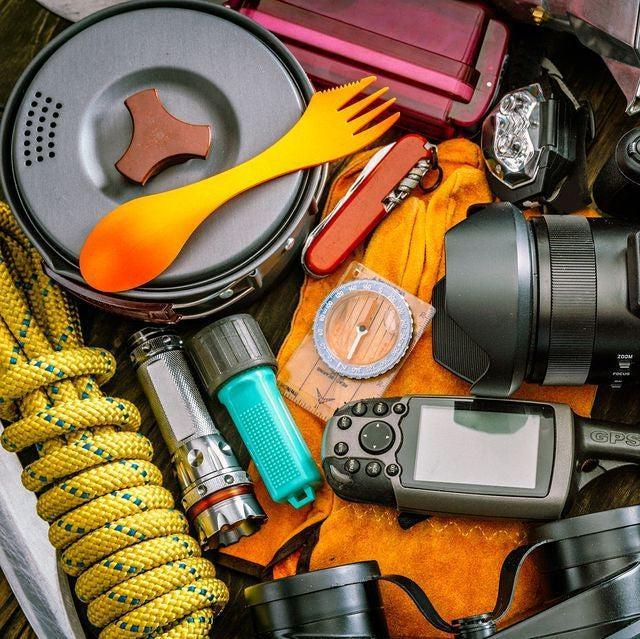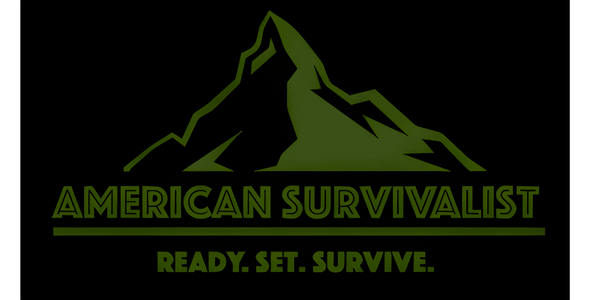
How to Build a Bug Out Bag: Essentials for 72-Hour Survival
Share
When disaster hits, you don’t get a warning. You don’t get time to think. You get minutes—sometimes seconds—to grab your gear and move.
That’s why every self-reliant American needs a battle-ready bug out bag packed and ready to roll. Whether it’s a wildfire barreling through your county, a hurricane bearing down on your coastline, or civil unrest boiling over in the streets, your bug out bag could be the difference between making it out or becoming another casualty.
But let’s be clear—a bug out bag isn’t just a backpack stuffed with random gear. It’s a carefully curated 72-hour survival kit, designed to keep you alive, mobile, and adaptable in the worst-case scenario.
This guide walks you through what to pack, how to pack it, and how to think like a survivor when building your bug out bag.
What Is a Bug Out Bag?
A bug out bag (BOB) is your lifeline when staying put is no longer an option. It’s a portable emergency kit containing everything you need to survive for at least 72 hours during a crisis.
Think of it like this: If you had to walk out your front door right now and couldn’t come back for three days—what would you need?
That’s what your bug out bag should answer.
From escaping wildfires in California, evacuating hurricanes in the Gulf, or navigating blackouts and chaos in a grid-down city, a well-built BOB is your last line of defense.
The 6 Survival Priorities Your Bug Out Bag Must Cover
Before you start tossing gear into your pack, understand your core survival priorities. These six categories form the backbone of any functional bug out bag:
- Water – Without hydration, you’ll crash fast. Three days without water can kill you.
- Food – You need calories to move, think, and stay sharp.
- Shelter – Exposure to cold, rain, or wind can be deadly.
- First Aid – Injuries are inevitable. Be ready to treat them.
- Security – You might need to defend yourself or signal for help.
- Tools – Fire-making, repairs, navigation—your gear must work as hard as you do.
Now let’s break down what you need in each category.
Bug Out Bag Essentials: What to Pack for 72-Hour Survival

Water & Filtration: Stay Hydrated or Die Trying
You’ll need at least one liter of water per person per day—more if you’re on foot or in hot climates. But water is heavy, so focus on finding and purifying along the way.
Pack:
- Collapsible water bottles or hydration bladder
- Portable water filter (Sawyer Mini, Katadyn BeFree, etc.)
- Water purification tablets (as a backup)
- Metal canteen (boil water over a fire if needed)
Field Tip: Always carry two purification methods. Filters can break. Fire doesn’t.
Emergency Food: Fuel for the Fight
This isn’t about gourmet meals. You need calories that are lightweight, durable, and ready to eat.
Best options:
- Freeze-dried meals (Mountain House, ReadyWise)
- High-calorie survival bars (Datrex, SOS Food Labs)
- Nut butter packets or peanut butter jars
- Instant oats, rice, or ramen
- Jerky and trail mix
Shoot for 2,000–2,500 calories per day. More if you’re covering ground.
Shelter & Warmth: Protect Against the Elements
Hypothermia can kill in hours—even in 50-degree weather. Your gear must protect you from wind, rain, and cold.
Include:
- Lightweight tarp or emergency bivy sack
- Mylar space blanket (multi-use and compact)
- Wool blanket or compressible sleeping bag
- Extra socks and thermal base layers
- Poncho or rain jacket
First Aid: Handle Injuries Like a Pro
You might not have access to a hospital. Your first aid kit must be able to handle trauma and treat minor injuries before they become major.
Must-haves:
- Israeli-style pressure bandage
- Antiseptic wipes and triple antibiotic ointment
- Trauma shears and tweezers
- Gauze rolls, medical tape, gloves
- Painkillers and anti-diarrheals
- 72-hour supply of prescription meds
Fire & Light: Heat, Cooking, and Morale
Fire is survival. It warms, cooks, sterilizes, and signals. Light keeps you moving and safe after dark.
Pack:
- Ferro rod or magnesium fire starter
- Waterproof matches in a sealed case
- Bic lighters (at least two)
- Emergency candles or tea lights
- Compact headlamp with extra batteries
Pro Tip: Store fire-starting gear in multiple compartments. Redundancy saves lives.
Tools & Gear: Your Lifeline in the Field
Your tools should be rugged, versatile, and proven in the field.
Key gear:
- Fixed-blade survival knife (4–6” blade)
- Multi-tool (Leatherman, Gerber, etc.)
- 550 paracord (25–50 feet minimum)
- Flat-wrapped duct tape (gear repairs, first aid)
- Compact folding saw
- Compass and waterproof map of your region
Don’t pack gimmicks. Every item should earn its weight.
Communication & Navigation: Stay Oriented and Informed
When cell towers go down, analog tools keep you alive.
Pack:
- Hand-crank or solar NOAA emergency radio
- Laminated local maps
- Signal mirror and survival whistle
- Pencil and waterproof notepad
Security & Self-Defense: Be Ready to Stand Your Ground
Threats in a crisis aren’t always environmental. Desperate people do desperate things.
Options:
- Pepper spray or bear spray
- Firearm (if legal and trained, with extra mags)
- Tactical flashlight (blinding beam can disorient attackers)
- Concealable fixed or folding knife
Caution: Know your local laws and train with your tools. A weapon you can’t use is a liability.
Hygiene & Sanitation: Stay Clean, Stay Healthy
In survival scenarios, disease spreads fast. A few simple items can protect you from infection and illness.
Pack:
- Toothbrush, toothpaste, biodegradable soap
- Baby wipes and hand sanitizer
- Toilet paper or compressed wipes
- Small trowel for digging catholes
Documents & Emergency Cash: When Digital Fails
ATMs go down. Cell service disappears. Be ready to operate offline.
Include:
- Copies of ID, insurance, and emergency contacts
- Local emergency plans or rally points
- $100–$300 in small bills (stash in multiple spots)
Real-World Bug Out Scenarios
Let’s bring it home. Here’s how your bug out bag plays out in different crisis settings:
Wilderness Survival
If you’re forced into the woods, shelter and fire are mission-critical. Carry a compact fishing kit or snare wire to extend your food supply. Know how to purify water from streams or ponds.
Urban Evacuation
In a city collapse, stealth and speed matter. Keep your bag low-profile—no tactical camo screaming “prepper.” Blend in, move fast, and avoid confrontation.
Navigation is key. Have printed maps and know your exits.
Off-Grid Homestead Emergency
Even the most hardened rural prepper may need to evacuate—wildfires, chemical spills, or armed conflict don’t discriminate. Know your rally points. Have comms gear to stay in touch with family. Pack for mobility, not comfort.
How to Pack Your Bug Out Bag
Packing is as important as what you pack. A poorly balanced bag will wear you down fast.
- Weight Distribution: Place heavy items high and close to your spine.
- Accessibility: Keep fire starters, first aid, and weapons in exterior pockets.
- Waterproofing: Line your pack with a trash compactor bag or use dry bags for key items.
Field Test It: Don’t just pack it—use it. Hike with it. Sleep outside with it. Know how it rides on your back and how fast you can access your gear. Practice like your life depends on it—because one day, it might.
Trusted Resources to Learn More
- Ready.gov Emergency Supply List – FEMA’s preparedness guide
- Red Cross Emergency Kit Tips
FAQ
What size backpack is best for a bug out bag?
Look for a 40–60 liter pack with a sturdy frame and padded straps. It should hold 20–30 lbs comfortably and ride high on your back.
How often should I update my bug out bag?
Every 6 months. Rotate out food, water, batteries, and meds. Adjust for seasonal needs and family changes.
Should every family member have a bug out bag?
Yes. Each capable person should carry their own essentials. Share group gear like shelter and cooking tools, but everyone needs water, food, and first aid.
Be Ready Before You Have to Run
Preparedness isn’t paranoia—it’s peace of mind. When things fall apart, it’s not the strongest who survive—it’s the most prepared.
Your 72-hour bug out bag is your lifeline when the world turns upside down. Build it smart. Test it hard. Carry it with confidence.
At American Survivalist, we’ve got your back with field-tested gear, training guides, and the hard-earned knowledge to help you and your family stay alive—no matter what comes.
Don’t wait until it’s too late!


